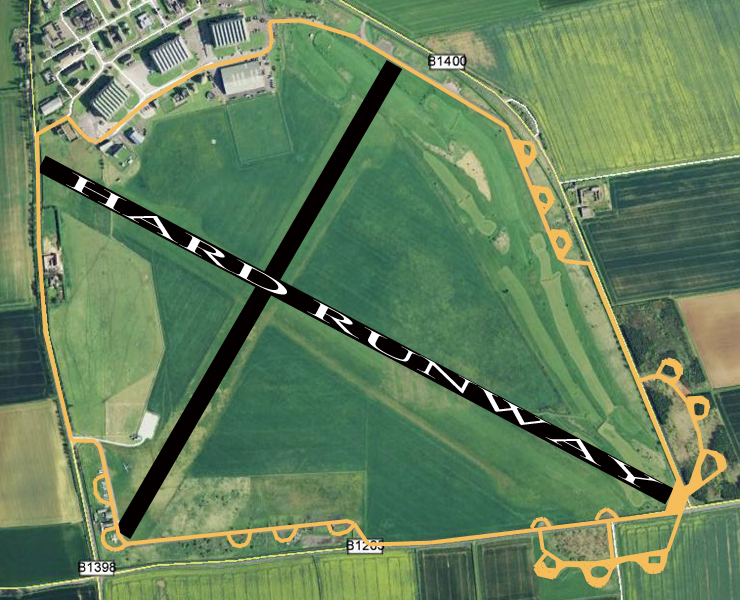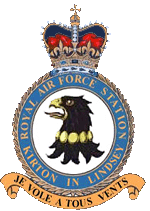Kirton in Lindsey Airfield History

(Map edited to show the airfield and runways 1940-45)

© Crown Copyright/MOD 2010
53°27'41"N 00°34'41"WRunways: ?
The Royal Flying Corps and later Royal Air Force airfield name Kirton in Lindsey was used during the First World War from December 1916 to June 1919. The airfield was used by detachments of No.33 Squadron from nearby Gainsborough until the squadron moved was based from June 1918, No.33 Squadron was a home defence squadron equipped with the Bristol Fighters and Avro 504s. With the end of the war, the airfield was returned to agricultural use.
Kirton in Lindsey was opened on a new site in May 1940 as a Fighter Command Station covering the NE of England during World War II. Many Defiant and Spitfire Squadrons rested here for a short time during the Battle of Britain. The airfield was home of No.71 Squadron of the RAF's Fighter Command. No.71 Squadron was composed of mostly Americans and was one of the "Eagle Squadrons" of American volunteers who fought in World War II prior to the American entry into the war. No.71 Squadron was assigned the squadron code XR. The squadron arrived at the station in November 1940. By January the squadron was declared combat ready and began flying convoy escort over the North Sea. On 9th April No.71 Squadron was moved to RAF Martlesham Heath. No.452 Squadron and No.457 Squadron, RAAF, both rested here for a while before departing for Australia in the summer of 1942.
Kirton in Lindsey was allocated to the United States Army Air Force 8th Air Force in 1942. It was assigned USAAF Station number 349, code "KL". Beginning in June 1942, the 94th Fighter Squadron of the 1st Fighter Group at RAF Goxhill used the station for training with Lockheed P-38 Lightnings. The squadron remained until October. Then in October 1942, the 91st Fighter Squadron of the 81st Fighter Group used the station for training. The squadron arrived in Europe from Muroc AAF, California flying Bell P-39 Airacobra's. The squadron remained until December then departed for French Morocco as part of 12th Air Force.
In May 1943, the station was transferred back to RAF control for use as a Fighter Operational Training Unit with Spitfires of No.53 OTU from RAF Llandow, RAF Caistor and RAF Hibaldstow. Kirton in Lindsey remained a front-line RAF base during the Cold War and afterwards. During World War II Kirton in Lindsey was home to a Fighter Command Sector Operations Room, fulfilling the same filtering and command and control functions as RAF Digby's Lima Sector Ops Room.
From 1948 to 1952 the station was home to various non-flying training schools of the RAF which were replaced by No.2 ITS (Later renamed No.1 ITS) until 1957, training with the Tiger Moth. From 1960 until December 1965, Kirton in Lindsey hosted No.7 School of Technical Training and a Gliding School.
In 1966, control of Kirton in Lindsey was transferred to the Royal Artillery and was renamed "Rapier Barracks". Due to the Royal Artillery association, the Army Cadet Force detachment which is housed there has the Royal Artillery cap badge.
The station spent the next 38 years as "Rapier Barracks" under Army control before returning to RAF ownership in 2004. Kirton in Lindsey became home to No.1 Air Control Centre (1ACC), the Unit having relocated from RAF Boulmer in 2004-05. Kirton also provides accommodation and messing for personnel based at RAF Scampton, and is also administered by them too. But all this was to change again in late 2013, with the airfield put up for sale by the MoD, leaving only personnel from Scampton using the living quarters.
| Date | Squadron | Notes |
|---|---|---|
| 1916 | Station opened. | |
| December 1916 | No.33 Sqn ('B' Flight) | Operating the Royal Aircraft Factory FE.2. The squadron disbanded at the station in June 1918. |
| June 1919 | Station closed. | |
| May 1940 | Station re-opened. | |
| May 1940 | No.65 Sqn | Operating the Supermarine Spitfire. The squadron left the station on the 14th June 1940. |
| May 1940 | No.222 Sqn | Operating the Supermarine Spitfire. The squadron left Kirton on the 29th August 1940. |
| May 1940 | No.253 Sqn | Operating the Hawker Hurricane. The squadron left the station on the 21st July 1940. |
| July 1940 | No.264 Sqn | Operating the Boulton Paul Defiant. The squadron left Kirton on the 23rd October 1940. |
| August 1940 | No.74 Sqn | Operating the Supermarine Spitfire. The squadron left the airfield on the 10th September 1940. |
| September 1940 | No.307 (Polish) Sqn | Operating the Boulton Paul Defiant. The squadron left Kirton on the 7th November 1940. |
| September 1940 | No.616 Sqn | Operating the Supermarine Spitfire. The squadron left the station on the 26th February 1941. |
| October 1940 | No.85 Sqn | Operating the Hawker Hurricane. The squadron left the airfield on the 21st November 1940. |
| November 1940 | No.71 (Eagle) Sqn | Operating the Hawker Hurricane. The squadron left Kirton on the 9th April 1941. |
| November 1940 | No.255 Sqn | Operating the Boulton Paul Defiant. The squadron left the station on the 15th May 1941. |
| February 1941 | No.65 Sqn | Operating the Supermarine Spitfire. The squadron left the airfield on the 7th October 1941. |
| April 1941 | No.452 (RAAF) Sqn | Operating the Supermarine Spitfire. The squadron left Kirton on the 19th July 1941. |
| May 1941 | No.121 (Eagle) Sqn | Operating the Hawker Hurricane and Supermarine Spitfire. The squadron left the station on the 16th December 1941. |
| August 1941 | No.136 Sqn | Operating the Hawker Hurricane. The squadron left the airfield on the 9th November 1941. |
| October 1941 | No.616 Sqn | Operating the Supermarine Spitfire. The squadron left the station on the 30th January 1942. |
| January 1942 | No.133 (Eagle) Sqn | Operating the Supermarine Spitfire. The squadron left Kirton on the 3rd May 1942. |
| March 1942 | No.486 (RNZAF) Sqn | Operating the Hawker Hurricane. The squadron left the airfield on the 9th April 1942. |
| June 1942 | No.457 (RAAF) Sqn | Operating the Supermarine Spitfire. The squadron left the station on the 8th June 1942. |
| August 1942 | No.316 (Polish) Sqn (Det) | Operating the Supermarine Spitfire. The squadron left the airfield on the 20th August 1942. |
| September 1942 | No.43 Sqn | Operating the Hawker Hurricane. The squadron left Kirton on 27th October 1942. |
| 1942 | Station control handed to the USAAF. | |
| May 1942 | No.306 (Polish) Sqn | Operating the Supermarine Spitfire. The squadron left the station on the 16th July 1942. |
| June 1942 | No.303 (Polish) Sqn | Operating the Supermarine Spitfire. The squadron left Kirton on the 2nd February 1943. |
| July 1942 | 94 Fighter Sqn / 1 Fighter Group | Operating the Lockheed P-38 Lightning. They left the airfield on the 27th August 1942. |
| October 1942 | 91 Fighter Sqn / 81 Fighter Group | Operating the Bell P-39 Airacobra. They left the station on the 23rd December 1942. |
| February 1943 | No.302 (Polish) Sqn | Operating the Supermarine Spitfire. The squadron left the airfield on the 17th April 1943. |
| February 1943 | No.317 (Polish) Sqn | Operating the Supermarine Spitfire. The squadron left the station on the 29th April 1943. |
| May 1943 | Station control handed back to the RAF. | |
| May 1943 | No.53 OTU | Operating the Supermarine Spitfire, Miles Master and Miles Martinet. The Operational Training Unit disbanded at the station on the 15th May 1945. |
| April 1946 | No.7 SFTS | Operating the Airspeed Oxford and North American Harvard. The Service Flying Training School left the airfield in March 1948. |
| June 1950 | No.22 GS | Operating the T21B Sedbergh and T31B Cadet. The Glider School closed in April 1955. |
| June 1952 | No.2 GS | Operating the Tiger Moth. The Grading School closed on 31st March 1953. |
| April 1955 | No.643 GS | Operating the T21 Sedbergh and T30 Prefect. The Glider School left the station on the 1st November 1965. |
| September 1959 | No.2 GC | Operating the T21B Sedbergh, T31B Cadet and T30B Prefect. The Glider Centre left Kirton in October 1965. |
| December 1965 | Station closed. | |
| 1966 | Station transferred to the Royal Artillery and renamed "Rapier Barracks". | |
| March 2004 | Station transferred back to RAF control. | |
| 2005 | No.1 ACC RAF | The Air Control Centre closed in 2013. |
| 2013 | RAF Kirton-in-Lindsey put up for sale. |
